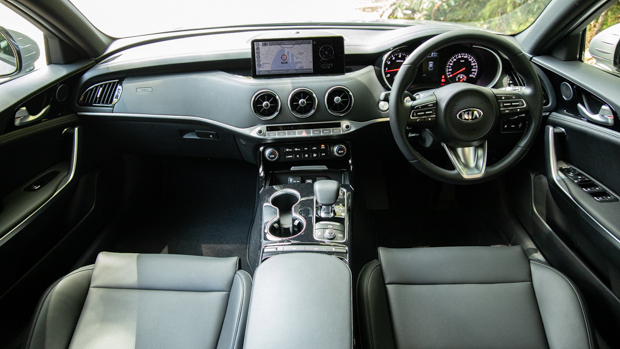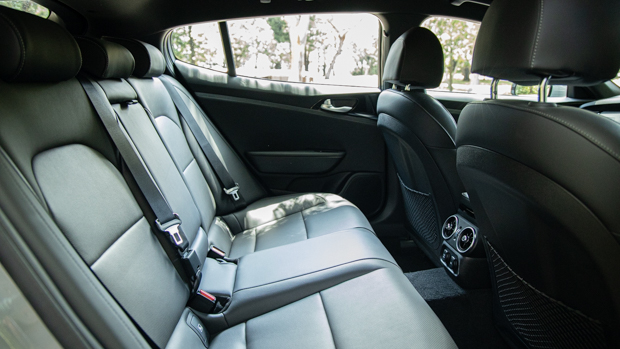-
Car Reviews
- Car News
-
Car Comparisons
Latest comparisons
- Chasing Deals
The Kia Stinger has been updated for 2021 with extra safety and convenience tech – but how does the most affordable Stinger, the four-cylinder 200S, stack up?

Just as Australian family buyers started to adopt SUVs en masse, Australia’s locally-made rear-wheel-drive heroes – the Holden Commodore and Ford Falcon – were shown the door. The Germans persist with the rear-drive, four-door formula, but at a cost. So, what’s a driving enthusiast with the need to carry four people on a mainstream budget to do?
Enter Kia. The rear-wheel-drive Stinger emerged to, in some ways, take the place of the Falcon and Commodore as a more affordable sports sedan. But with its fastback shape and wide-opening hatch, it’s not really a sedan at all.
The Stinger has enjoyed moderate success since its launch in Australia in 2018, when we thought it was something of a rough diamond in twin-turbo V6 GT form. Over time, Kia have tinkered at the Stinger’s dynamics, culminating in a mid-life facelift for the 2021 model year.

Under the microscope here is the most affordable Stinger 200S grade, which is priced at $49,550 ($53,090 driveaway). The entry-level 200S now scores higher levels of equipment with a two-litre turbocharged engine.
Outside, the changes to the 2021 Stinger are subtle. You’ll note the new 18-inch wheel design – which isn’t attractive to our eyes – and a more intricate LED daytime running light signature. We did like the new Ceramic Silver duco worn by our test car, which evoked Audi A5 Sportback vibes.
But does the 200S still deserve to live in the shadow of the headline-grabbing GT, which uses a much beefier 3.3-litre twin-turbo V6? And, more broadly, is this circa-fifty grand Stinger a worthy alternative to a more traditional family car like a Mazda CX-5 or Toyota RAV4?
Fitted under this Stinger’s long bonnet is a turbocharged two-litre four-cylinder engine which kicks out 182kW of power and 353Nm of torque. This is the same engine as you’ll find in a Hyundai i30 N hot hatch, in fact, though with a little less power.
Sadly, without the i30 N’s pop and crackle exhaust antics, the Stinger 200S’s engine is rather lacking in character.
While Kia claims a respectable 0-100km/h sprint time of six seconds, the Stinger feels slower in the real world. To make progress the ‘four really needs more than 3,000rpm on the clock, and yet it runs out of puff up top, meaning you’re limited to the midrange.

It’s an adequate engine for cruising around town, but the 274kW (up 2kW for 2021) and 520Nm 3.3-litre twin-turbo V6 is sweeter and better amplifies the Stinger’s muscular character.
For us, the V6 is what the Stinger is all about. The six-cylinder is a modest $3,780 upgrade in the 330S variant that matches the 200S for equipment levels.
No matter the engine, Stingers send power to the rear wheels via an eight-speed torque converter automatic gearbox that now – finally – allows manual gear override indefinitely, without a timer, through steering wheel-mounted paddles. That’s a relief, because the programming of the auto gearbox is fairly lazy.

Dicing along country tarmac brings the four-cylinder Sting’s pleasant handling balance to the fore. Driven with accuracy, the Stinger makes confident progress. Push deeper into the grip reserves, though, and you feel each one of those 1,700kgs scrubbing the front wheels wide.
The six’s extra power and limited-slip differential mean this can be cured with a confident stab of the right boot, but the four-cylinder doesn’t have the immediacy to bring the rear end into play. The balance is safe and neutral, but not as athletic as the styling suggests.
Kia has clearly worked hard at refining the Stinger’s ride, and with 18-inch wheels the passive setup on our 200S was near perfect for Australian back roads. Slightly abrupt below 50km/h, once up to speed the Stinger hustles and flows over Sydney’s lumpy tarmac.

Opting for the GT-Line and GT grades nets adaptive dampers which meld with the customisable drive modes. On our 200S, the drive modes only tweak throttle response and steering weight. In sport, the steering is absurdly heavy, comfort is better if a little on the light side. The firm brake pedal, though, inspires plenty of confidence.
Navigating urban environments is easy, the Kia’s shape is conventional, and although long in the nose, the bonnet’s edge is as easy to judge. That’s lucky, given only the GT and GT-Line have front parking sensors.
However, active safety technology is superb and includes AEB with pedestrian, cyclist and junction functionality – incredible at this price. Things you’ll notice more regularly are the impressive adaptive cruise control, lane-keep assist and blind-spot monitoring. GT and GT-Line grades are equipped with rear cross-traffic alert and reversing AEB.
Rather like the exterior, the Koreans have been paying close attention to the German school of interior design. Scratchy plastics and boring design make way for a contemporary layout. There are three circular vents above the Stinger’s broad centre stack, which carries elegant contours that aren’t dissimilar to what you’d find in a Mercedes-Benz.
An attractive leather-wrapped steering wheel finishes off a tightly screwed together and well-appointed cabin. Sadly, the snazzy digital instrument cluster fitted to the Kia Sorento large SUV have not made it into the Stinger. Clear analogue items do the job, and a sizable 10.25-inch touchscreen navigation system is new for 2021. Most will skip Kia’s own software and use wired Apple CarPlay and Android Auto, though, which work via a USB-A cable.
For 2021, the Stinger 200S’s electrically-adjustable seats are now leather-appointed, bringing the ambience up from the outgoing cloth pews. There’s electric adjustment for both front seats, but for more plush Nappa leather, you’ll need to step up to the four-cylinder GT-Line ($57,230) or the V6 GT ($63,260).cloth items before – Nappa Leather features on the GT-Line and GT.

Those more expensive Stinger grades models also get lumbar support that our base car misses out on. While the seats were a touch flat, we found the driving position to be natural, low and sporty.it was easy to adopt a natural, sporty driving position.
The Stinger’s centre console houses storage for your phone beneath a spring-loaded cover. There are two cupholders of different sizes and a large central bin under a comfy armrest. Storage is adequate for front passengers.
Those who sit in the rear of the Stinger will be comfortable, too, for this wide fastback offers palatial space in the second row. There is more legroom than you can poke a basketballer’s knee at, and headroom enough for this six-foot-two tester. The only clincher is the mountainous hump in the floor, which restricts this car to carrying four adults in comfort.

Those in the back do get to use the soft and broad centre armrest with two deployable cupholders, and if they happen to have more water bottles, the door bins will take up to 700ml items. If there is one complaint, the back bench lacks support. There is a USB port and a 12-volt socket to power devices, as well as standard rear air vents.
It’s at the rear the Stinger’s practicality comes to a pleasant crescendo. The 404 litres of boot space isn’t enormous on paper, but the Stinger’s huge hatchback means loading cargo is easy. That said, on the 200S, the hatch is manual, and it’s pretty high and heavy.
Those who prefer a power tailgate can look to the up-spec GT-Line and GT grades.

The Kia Stinger is relatively affordable to run for a sports sedan. However, the Stinger mainly benefits from this brand’s generous warranty arrangements.
Kia proudly displays their benchmark seven year warranty coverage period on a decal on the Stinger’s back window. Most rival manufacturers offer only five years of coverage – and an Audi A5 Sportback that is a similar shape has a mere three year warranty.
Servicing the Stinger is done in intervals of 1 year or 10,000 kilometres – whichever comes first. That short distance between services is less convenient than many cars. This also isn’t an especially affordable vehicle to service.

The first five years or 50,000 kilometres of servicing will cost $310, $498, $399, $685, and $351 apiece, bringing the average service bill to $507.
On the fuel consumption front, Kia claims that the four-cylinder Stinger uses 8.8L/100km. In a rare feat, we bested the manufacturer’s statement on this test, recording 8.5L/100km, which is quite respectable for a vehicle of this size and ability.
The Stinger will happily consume E10 petrol fuel, whereas European rivals impose a premium octane-only restriction.
Kia’s running tweaks have made the Stinger 200S a far more complete package. However, while this is a balanced and enjoyable grand tourer, the four-cylinder engine simply doesn’t sparkle in the 2021 Kia Stinger. The amount of power on offer isn’t to adequately engage the chassis.
We’d walk past the two-litre grades, and spend a little more on the Stinger 330S or GT variants with the engine this car really deserves: the 274kW twin-turbo V6.
In 330S form, the Stinger offers fantastic value reminiscent of hot Australian sedans past – but either way, we’re glad that cars like the Kia Stinger still exist.

Variant tested 200S
Key specs (as tested)
About Chasing cars
Chasing Cars reviews are 100% independent.
Because we are powered by Budget Direct Insurance, we don’t receive advertising or sales revenue from car manufacturers.
We’re truly independent – giving you Australia’s best car reviews.
The estimate provided does not take into account your personal circumstances but is intended to give a general indication of the cost of insurance, in order to obtain a complete quote, please visit www.budgetdirect.com.au. Estimate includes 15%^ online discount.
^Conditions Apply
Budget Direct Insurance arranged by Auto & General Services Pty Ltd ACN 003 617 909(AGS) AFSL 241 411, for and on behalf of the insurer, Auto & General Insurance Company Limited(ABN 42 111 586 353, AFSL 285 571).Because we don’t know your financial needs, we can’t advise you if this insurance will suit you. You should consider your needs and the Product Disclosure Statement before making a decision to buy insurance. Terms and conditions apply.
Indicative quote based on assumptions including postcode , 40 year old male with no offences, licence suspensions or claims in the last 5 years, a NCD Rating 1 and no younger drivers listed. White car, driven up to 10,000kms a year, unfinanced, with no modifications, factory options and/or non-standard accessories, private use only and garaged at night.
^Online Discounts Terms & Conditions
1. Discounts apply to the premium paid for a new Budget Direct Gold Comprehensive Car Insurance, Third Party Property Only or Third Party Property, Fire & Theft Insurance policy initiated online on or after 29 March 2017. Discounts do not apply to optional Roadside Assistance.
2. Discounts do not apply to any renewal offer of insurance.
3. Discounts only apply to the insurance portion of the premium. Discounts are applied before government charges, taxes, levies and fees, including instalment processing fees (as applicable). The full extent of discounts may therefore be impacted.
4. We reserve the right to change the offer without notice.